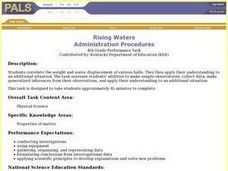Curated OER
Couriers in the Inca Empire: Getting Your Message Across
Students explore how the Inca communicated across the bast stretches of their mountain realm.
Curated OER
Collecting and Recording Data# O
Learners observe plants growing over time, measure specific plant growth, and gather and record data on plan growth.
Curated OER
Balloon Rockets
Students build pinwheel airplanes and balloon rockets to determine which ones fly faster and which fly farther.
Curated OER
poem "Smart" by Shel Silverstein from "Where the Sidewalk Ends"
Students incorporate their conceptual understanding of proportions to write a creative piece similar to the example poem.
Curated OER
IT'S PLAY TIME
Young scholars focus on several objects which causes them to move in different directions during this outdoor activity.
Curated OER
Lesson Plan on the Appalachians - People, Culture, Lifestyles
Fourth graders examine and discuss the location, lifestyle, and culture of the people of the Appalachians. They listen to a tape of an Appalachian dialect, the story, When I Was Young in the Mountains, and write and conduct questions for...
Curated OER
Compass Crusaders
Students discover how to use a compass and how to use that knowledge in the field while applying orienteering and mathematical skills.
Curated OER
The Difference Between Comets, Meteors And Asteroids
Students use Venn diagrams to highlight the similarities and differences between comets, meteors, and asteroids.
Curated OER
Putting Your Best Foot Forward
Third graders measure their feet and their parents' feet, record data on computer-generated graphs, and calculate and record mean, median, and mode.
Curated OER
High and Low Tides
Students collect real world data from the Web regarding high and low tides at various locations in the United States. They find a function which models this data and make predictions on tide levels based on the information found.
Curated OER
Surface Meteorological Observation System (SMOS)
Students investigate local surface weather conditions. They log weather conditions for thirty days, develop a graph, plot cloud cover, and compare/contrast the graphed lines of various weather factors.
Curated OER
Floating Pencil
Students discover how salt water makes a pencil float better than freshwater by measuring and comparing the lengths of the portion of the pencil that floats above the water surface. They then determine if an unknown water sample is...
Curated OER
Rising Waters
Fourth graders rank balls by size from smallest to largest and from lightest to heaviest and then by how much they made the water rise. They then discuss why certain balls make the water rise higher than do other balls.
Curated OER
Temperature School
Students observ the cooling and warming of room temperature, hot, and ice cold cans of water by measuring the change in temperature over time. They then attempt to develop explanations for the observations made and apply their findings...
Curated OER
Balls and Ramp
Students role several balls of different weights down a ramp and into a paper cup and record how far each ball made the paper cup move. They then answer questions that help them analyze their results and reinforce the idea that energy...
Curated OER
Swingers
Young scholars investigate the motion of a swinging pendulum. They experiment with a pendulum to find out why it might swing at different speeds at different times.
Curated OER
Colored Dots 1
Young scholars observe that colored markers are a mixture of many different colors by performing a chromatography experiment. They make observations, record information, and make generalized inferences from their observations.
Curated OER
Observing Objects
Students observe the motion of both a pendulum and a spring pendulum . They then explain the differences and the similarities between the two types of motions.
Curated OER
Plastic Wrap
Students compare the price and quality of different kinds of plastic kitchen wraps and then rank them from best to worst. They take into account how well it comes out of the roll, if it seals well, it is tangles, how much weight it...
Curated OER
Colored Drops
Students examine the properties of a liquid that contains water and food coloring and a liquid that contains water, food coloring and a liquid detergent. They interpret their data, describe properties, and make reasonable explanations...
Curated OER
Predator/Prey Relationship
Students study and analyze data collected on the relationship between the snowshoe hare and lynx in Canada over a 28 year period and create a graph. Students also write a response to a proposal to reduce the lynx population.
Curated OER
Clothespin Magnets
Learners decorate letter, clothespin magnets using basic art supplies in this Art lesson for the elementary classroom. Teacher preparation should include cutting out letter shapes for each student and connecting clothespins prior to the...
Curated OER
Fractions: Parts of a Set
Students identify, model, and label simple fractions. They describe and define them as equal parts of a whole, a region and a set. Students use words to describe fractions. They use manipulatives to explore the many different fractions.
Curated OER
Natural Selection
Eighth graders define natural selection and adaptation. They simulate natural selection within a species and relate the elements of natural selection to the simulation. They analyze the results of natural selection in terms of...

























